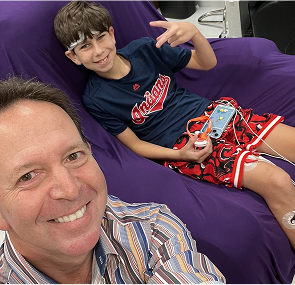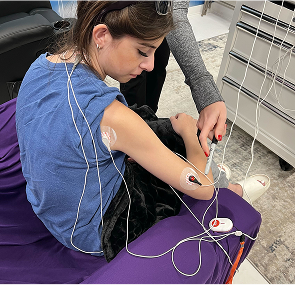Scrambler Therapy Pad Placement: Why It Matters and What to Expect

A non-invasive procedure called scrambler therapy works by interfering with the peripheral nervous system's maladaptive pain signaling to alleviate chronic pain. Developed in Italy and later cleared by the FDA, this therapy targets neuropathic conditions like chemotherapy-induced neuropathy, CRPS, and fibromyalgia.
The treatment works by delivering artificial nerve signals via electrode pads, which are placed on the skin near the pain zone but not directly on the most painful spot. The primary factor influencing the effectiveness of treatment is the electrode location. Correct pad configuration influences how well the device scrambles pain signals and reroutes them to restore neuroplastic balance.
Key Concepts:
- Electrode positioning impacts pain signal interruption.
- ST pad configuration changes per condition.
- The therapy works by modulating spinal cord pathways without drugs or surgery.
In the next section, we’ll explain exactly how this system works on a biological level.
How Does Scrambler Therapy Work on a Neurological Level?
Scrambler Therapy alters the central nervous system’s pain perception by introducing non-pain information into the afferent nerve pathways through surface electrodes. This triggers a process called neuromodulation, leading to synaptic inhibition of chronic pain signals.
Mechanism Summary:
Scrambler Therapy Pad Placement impacts this process by determining which nerve groups receive the artificial signal. Pads must sit on intact skin, over unaffected but corresponding dermatomes, to create an accurate signal confusion effect.
Let’s examine why precision in pad positioning is not optional—it's vital.
Why Is Precise Pad Placement Essential for Scrambler Therapy?
Pad misplacement reduces Scrambler Therapy efficacy. Incorrect electrode alignment can lead to failed sessions, misrouted signals, or even increased discomfort.
Why Placement Precision Matters:
- Pain mapping determines where pain signals originate.
- Dermatomal targeting ensures the artificial signal reaches the right spinal pathway.
- Correct pad application enhances stimulation accuracy and comfort.
- Poor placement can trigger sensitivity mismatch or ineffective neuromodulation.
Patient mapping is used during initial evaluation to understand the sensory thresholds and identify the best electrode sites. This process requires anatomical expertise and experience.
Next, we look at a practitioner known for his clinical success with pad placement: Dr. Markson.
Who Is Dr. Markson and What Is His Approach to Pad Placement?
Dr. Markson is a board-certified Scrambler Therapy specialist known for his evidence-based pad placement strategies. His approach combines advanced training, individualized protocols, and outcome tracking to ensure maximum treatment success.
Dr. Markson’s Key Methods:
- Makes use of patient-specific methods based on the anatomy and type of pain.
- Incorporates clinical outcomes into ongoing therapy optimization.
- Tracks success metrics using pre- and post-session pain scores.
- Trains under internationally recognized Scrambler Therapy programs.
His protocol consistently shows higher response rates due to expert pad alignment, especially in patients with fibromyalgia and sciatica.
To better understand this, let’s visualize how pads are placed in common conditions.
Visual Guide: Where Are Scrambler Therapy Pads Placed?
Electrode pads are placed based on pain origin, not just surface location. Unlike TENS devices, pads in Scrambler Therapy are placed proximal to pain zones, often across multiple dermatomes to reach the right neural pathways.
Common Pad Configurations:
Visual placement guides are often used in clinics. These Scrambler Therapy pad maps help standardize treatment while allowing for personalized adjustments.
In the next section, we’ll look at how placement varies by condition type.
How Does Scrambler Therapy Pad Placement Differ by Condition?
Each neuropathic condition affects different nerve clusters. Pad placement must adapt to the location-specific pain signals and neural response patterns.
Tailored Electrode Plans by Condition:
- Chemotherapy-induced neuropathy: Pads on ankles and hands, bypassing chemo-affected nerves.
- Fibromyalgia: Multi-point strategy over neck, shoulders, hips, to cover widespread pain.
- Phantom limb pain: The pads on the relevant dermatome zones of the residual limb.
- Herniated disc: Pads on paraspinal muscles adjacent to the impinged nerve.
- Post-op knee pain: Above and below the knee, avoiding surgical scar area.
Correct condition-based placement increases therapy efficacy by targeting the right afferent nerve pathways.
Now, here’s what to expect during your first Scrambler session.
What Happens During a Scrambler Therapy Session?
A standard Scrambler Therapy session includes consultation, pad configuration, signal calibration, and active stimulation.
Scrambler Therapy Protocol Steps:
- Initial consultation and pain mapping.
- Skin preparation to improve electrode contact.
- Pad placement based on dermatomal analysis.
- Calibration to set a patient's comfort threshold.
- The therapy session lasts ~45 to 60 minutes.
- Electrode reconfiguration may occur mid-session based on feedback.
Patients typically feel a mild tingling—never pain. Throughout the session, the electrical comfort level is adjusted using a feedback loop system.
What does the clinical evidence say about the effectiveness of correct pad placement?
Is There Research Supporting Scrambler Therapy Pad Placement?
Yes. Clinical studies and trials have confirmed that expert pad placement directly correlates with improved treatment outcomes.
Key Research Findings:
- According to NIH-funded studies, patients who have their pads properly positioned experience 40–80% less pain.
- Randomized control studies highlight a 25% efficacy drop when placement errors occurred.
- Pain journals have reported that correct dermatomal targeting enhances signal rerouting consistency.
- Placement error margins of even 2–3 cm resulted in lower neuromodulation efficacy.
Placement success is now considered a primary predictor in Scrambler Therapy response.
Now let’s compare Scrambler Therapy to a more familiar method: TENS.
How Is Scrambler Therapy Pad Placement Different From TENS?
TENS devices apply stimulation directly over the pain site using superficial targeting. An alternative method for redirecting impulses away from pain sites is Scrambler Therapy, which involves nerve-level participation and dermatomal analysis.
Scrambler vs TENS Pad Logic:
This makes Scrambler more complex—but also more effective for chronic neuropathic pain.
Now, let’s cover what happens when pad placement is done incorrectly.
What Can Go Wrong With Incorrect Pad Placement?
Improper pad placement can cause ineffective sessions, worsened symptoms, or unintended side effects.
Common Risks:
- Signal misrouting causing incomplete pain relief.
- Overstimulation leading to discomfort or fatigue.
- Electrode misalignment reduces signal penetration.
- Reduced efficacy from poor nerve targeting.
- Poor contact or pad reuse might cause skin irritation.
Therapy failure reasons are most often traced back to bad electrode positioning, not device malfunction.
Let’s address some frequently asked questions next.
FAQs About Scrambler Therapy Pad Placement
Where are the pads placed during Scrambler Therapy?
Pads are placed on healthy skin near the pain site, based on nerve pathways, not pain location.
Does pad placement hurt?
No, placement is painless. You may feel tingling during the session, which is normal.
Who places the electrodes?
Only trained therapists or certified clinicians apply the pads using anatomic guidelines.
How long does pad placement take?
Pad positioning takes around 5–10 minutes, depending on condition complexity.
How many sessions are needed?
Most patients receive 8–12 sessions for full results. Frequency depends on pain severity and response.
How to Choose the Right Scrambler Therapy Provider
Choosing an experienced provider is key. Scrambler Therapy requires skillful electrode targeting that only certified and trained professionals can deliver.
What to Look for in a Provider:
- Board certification or ST-specific training
- Verified clinical outcomes
- Transparent patient testimonials
- Experience with your specific pain condition
- Ability to offer custom treatment plans
Dr. Markson, for example, has helped hundreds of patients by combining clinical expertise with precise therapeutic targeting.
Tip: Ask your provider about their pad placement strategy and how they map pain pathways.
Experiencing Chronic Pain in South Florida?

Discover South Florida Scrambler Therapy is one of the nation’s leading clinics for noninvasive chronic pain relief, offering FDA-cleared Scrambler Therapy® for adults and children. Co-founded by Dr. Rick Markson, one of the few practitioners worldwide to receive advanced certification directly from the therapy’s inventor in Rome, our clinic delivers globally recognized expertise with compassionate, personalized care. If you or a loved one is living with treatment-resistant nerve pain, we invite you to schedule a consultation and explore a life beyond pain.
Recommended Reads:
📘 What is scrambler therapy?
📘 What to Expect During a Scrambler Session
📘 CRPS Pain Relief Without Drugs—Real Patient Stories
📘 Conditions that scrambler therapy can treat
Take the Next Step: Free Consultation at South Florida Scrambler

Every day counts when we suffer from chronic pain. South Florida Scrambler Therapy offers a free initial consultation to determine if Scrambler is right for you. Schedule Today:
- Speak directly with Dr. Rick Markson’s team
- Learn about treatment protocols and insurance
- Complete a customized treatment plan
- Start seeing results within days, not months
📞 Call Now or Visit website: www.southfloridascramblertherapy.com
📍 We serve Palm Beach, Fort Lauderdale, and Miami from our location at 100 NW 100th Ave, Plantation
You Can Follow Us through Our Social Media:
📸Instagram—Day-in-the-life stories from our patients
👍Facebook—Success journeys and community support
You deserves to laugh, and enjoy life without pain. The journey starts here.
Start Your Nerve Pain-Free Journey Today






